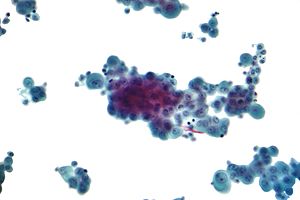Peritoneal mesothelioma
| Peritoneal mesothelioma | |
|---|---|
 |
|
| Micrograph of a cytopathology specimen showing mesothelioma. The cytopathologic appearance of mesothelioma in the pleural cavity and peritoneal cavity is not distinguishable. | |
| Classification and external resources | |
| Specialty | oncology |
| ICD-10 | C45.1 |
Peritoneal mesothelioma is the name given to the cancer that attacks the lining of the abdomen. This type of cancer affects the lining that protects the contents of the abdomen and which also provides a lubricating fluid to enable the organs to move and work properly.
The peritoneum is made of two parts, the visceral and parietal peritoneum. The visceral peritoneum covers the internal organs and makes up most of the outer layer of the intestinal tract. Covering the abdominal cavity is the parietal peritoneum.
Symptoms of peritoneal mesothelioma include weight loss and abdominal pain and swelling due to a buildup of fluid in the abdomen. Other symptoms of peritoneal mesothelioma may include bowel obstruction, blood clotting abnormalities, anemia, and fever. If the cancer has spread beyond the mesothelium to other parts of the body, symptoms may include pain, trouble swallowing, or swelling of the neck or face.
Peritoneal mesothelioma has two clinical types which can be differentiated with the help of CT findings, the "dry" type and the "wet". It is classified as "dry" when there are multiple tiny masses or one dominant localized mass and generally little or no ascites. The "wet" type has widespread small nodules, no dominant mass and a presence of ascites. If fluid is found, the process of eliminating it is through paracentesis; however the analysis of this fluid has limited diagnostic significance. Normally, a definitive diagnosis may be obtained through tissue biopsy.
Asbestos is a known cause of peritoneal mesothelioma in humans.
A 1975 study of three small villages in central Cappadocia, Turkey—Tuzköy, Karain and Sarıhıdır—found that peritoneal mesothelioma was causing 50% of all deaths. Initially, this was attributed to erionite, a zeolite mineral with similar properties to asbestos, but detailed epidemiological investigation demonstrated that the substance causes the disease mostly in families with a genetic predisposition to mineral fiber carcinogenesis. The studies are being extended to other parts of the region.
...
Wikipedia
